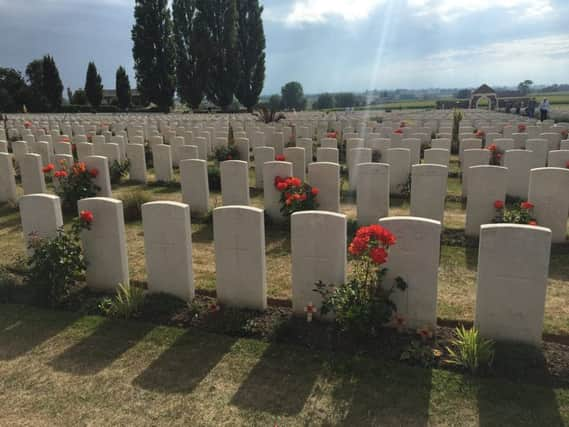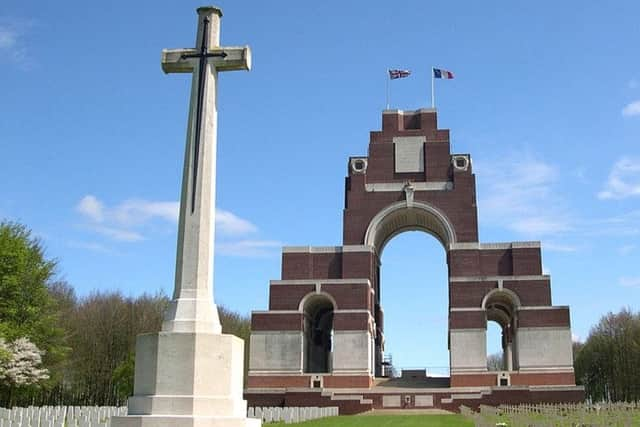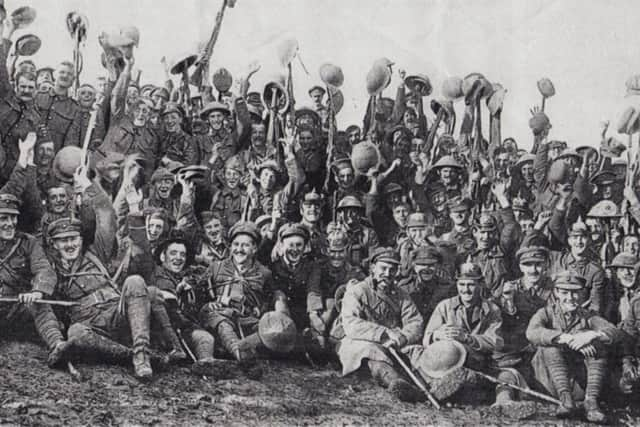Memories of men lost amid carnage from the Great War


Although the fighting ended, that was not the end of the war. The Armistice was prolonged three times to enable tortuous peace negotiations to be concluded before the war officially ended with the signing of the Treaty of Versailles on June 28, 1919.
Estimates of casualties in the First World War (FWW) vary but figures between 40-50 million military and civilian casualties are often cited.


Advertisement
Hide AdAdvertisement
Hide AdThe Entente Powers (the Allies) lost about 5.7million soldiers, while the Central Powers lost about 4million.
Estimates of civilian deaths, largely due to war-related famine and disease, range from five-to-10million. More than 26million military personnel were wounded.
Throughout the FWW centenary years, Northumberland Branch of the Western Front Association (WFA) has been undertaking a project aimed at building a fitting, and lasting, legacy to honour the response of the 60 or so local communities in the wider Alnwick, Amble, Rothbury and Wooler districts to the nation’s call to arms in 1914-1918, through the creation of an online database of those men who were lost, killed in action or died in the service of their country. Progressive versions of the database have been available online since May 2013, courtesy of Alnwick’s Bailiffgate Museum which currently hosts its internet presence via the website at www.bailiffgatemuseum.co.uk/ww1To ensure the content created remains safe and accessible for future users, as well as with the museum, the WFA is working with Northumberland Archives and the North East War Memorials Project, to capitalise on preservation of their websites for the future in the UK Web Archive by having the WFA’s database embedded and integrated within their website platforms. This work will be completed next year.
Paul Ternent, of the Northumberland Archives, said: “We are pleased to offer our support to this worthwhile project. It’ll be a fantastic resource for our users to work with and complement our existing finding aids. During November, we’re planning to post a number of social-media articles relating to the end of the war.”


Advertisement
Hide AdAdvertisement
Hide AdThese articles can be checked on the Archives’ Facebook page – northumberlandarchives; Twitter – northldarchives; and the website – www.northumberlandarchives.comAs well as delivering a database for online use, the aim is to publish it as a book, for limited circulation. The stories therein will provide greater recognition and be a fitting tribute to those men who paid the ultimate sacrifice in the service of their country, so contributing to the historical record of North East life in the 20th century.
Target markets for a published work will include schools, libraries, local history community groups, local museums and local authorities.
While the online database should meet the needs of most family historians by delivering a searchable resource for individual inquiries – on casualty’s name; regimental service number; rank; regiment and battalion; date killed or died; age; where commemorated or buried, if found; service history; background information including such as when and where born, family details, where educated, pre-service occupation, etc; and where commemorated locally – as is, it’s not something capable of being read and analysed online in its totality. The intention is to deliver a solution to this shortcoming, next year.
Work has recently been completed on v.14 of the database, which has expanded to 1,540 casualties, ie, deaths of men who were born and/or were resident and/or enlisted in the wider Alnwick, Amble, Rothbury, and Wooler districts.
Advertisement
Hide AdAdvertisement
Hide AdThere is no reason to believe the statistics in relation to local casualties are any different from the national experience, so a reasonably accurate estimate of local men wounded would be 3,500-3,600, and the number of men who responded to the call to arms would have been more than 15,000.
The NF 1st Battalion’s War Diary reveals the order to mobilise was received at 6pm on August 4, 1914. By 7.15pm, an officer and NCO had been despatched to Newcastle to collect reservists flocking into the regiment’s depot to bring the battalion up to its established war strength. The following day, the battalion moved into Portsmouth, to undergo medical inspections and prepare for service overseas. During the following week, Reservists continued to arrive from various locations.
On August 13, the battalion left Portsmouth by two special trains for Southampton and embarked on SS Norman, with transport and horses embarking on SS Italian Prince. Embarkation was completed at 3pm and, an hour later, the first ship sailed for an ‘unknown destination’.
When they’d been at sea for about an hour, it was given out that they were destined for (Le) Havre, which was sighted before midnight.
Advertisement
Hide AdAdvertisement
Hide AdAfter disembarking at Le Havre, within an hour the men were marched five-and-a-half miles to a rest camp. The weather was very hot, and 82 men fell out during the march. The camp was not ready for them, there was no water to wash or drink.
Quite how long it was before water carts were available is not recorded in the diary.
At midnight on August 15, the battalion paraded in drenching rain, ready to move off for a rail journey to Rouen.
During their steady moves towards the Front over the next few days, the men were greeted by enthusiastic crowds who showered them with fruit, cigarettes, coffee and flowers.
Advertisement
Hide AdAdvertisement
Hide AdProgress stopped at Noyelles where the men were billeted in barns and farm houses for three days, only leaving their billets for short route marches.
At 5.45am on August 21, the men left Noyelles and marched 12-and-a-half miles to Longville, then, next day, they moved on Cuesmes, near Mons, in the province of Hainaut, Belgium. B and C Companies were detailed to take up an outpost position on the Mons-Conde canal.
By August 24, with B and C Companies still in the position they had taken up the previous day, the three bridges and streets in their area were strengthened with barricades and nearby houses were fortified.
At 11am, C Company was attacked by heavy shell fire which turned onto B Company at noon accompanied by heavy rifle fire.
Advertisement
Hide AdAdvertisement
Hide AdThe enemy gradually massed in large numbers in the dead ground in front of B Company and were able to bring two field guns to within 150 yards of the main barrier which was blocking the street leading to the bridge head.
The Company were unable to locate the exact position of the enemy due to smoke from the guns and house fires, but they were under the impression the Germans suffered heavy losses.
Three men from the company were holed up in a house next to the bridge when the house was shelled. One man was killed and the other two made their escape through the cellar. The bridge was now undefended and within 10 minutes of the explosion German troops began to stream over.
Meanwhile, at 10am, A and C Companies were sent to the northern outskirts of Cuesmes to take up position to cover the retirement of the support line. At 2pm, they were again ordered to retire and followed B Company west to Frameries.
Advertisement
Hide AdAdvertisement
Hide AdUnfortunately, they were attacked from the west by a force of Germans who had followed behind. The Royal Scots Fusiliers were the first to meet this attack and suffered heavy casualties.
The NF’s A and D Companies – John Willcox, one of the first local men to fall, was a member of the latter – were sent to their support and continued doing a flank guard movement until dark when the battalion concentrated on the high ground west of Frameries.
This first action cost 1/7th Fusiliers – eight men killed and 11 injured.
Corporal William Purvis, MM and Bar, was the son of George and Elizabeth Purvis, of Richmond Villa, Horncliffe. He enlisted at Alnwick, along with his three brothers, and joined the NF’s 1/7th Battalion TF before later transferring to the 149th Company of the Machine Gun Corps (MGC).
Advertisement
Hide AdAdvertisement
Hide AdPurvis was twice awarded the prestigious Military Medal (MM), on the first occasion for gallantly serving his machine gun under very heavy German fire.
This was during the Battles of the Somme and the capture of High Wood, on September 15, 1916.
The second occasion was in action near Arras in May, 1917, where he held a trench against heavy German attacks when all his comrades had become casualties.
Purvis had fallen before he could receive his award, so his mother was presented with it at Berwick Barracks.
Advertisement
Hide AdAdvertisement
Hide AdAnother recipient of the MM was Lance Corporal George Halliday Balmer, MM, who also served with the 149th Company of the MGC after first joining the NF.
Born about 1894, at Wooler, Balmer was one of four sons lost during the war. An older brother, James (NF 9th (Service) Battalion), had already been lost in 1915, and a younger brother, John (Alexandra, Princess of Wales’s Own (Yorkshire Regiment, 2nd Battalion) was lost less than four months before George’s demise.
The fourth son lost was Thomas Frederick Balmer, who did not serve with the Armed Forces. He worked in the munitions industry and died from Lyddite poisoning.
The WFA’s database remains a work in progress. It is not too late for anyone with family stories of men who paid the ultimate sacrifice during the FWW to have them added to the database and preserved for posterity. Photographs of those who served and died would be especially welcomed. Email [email protected] Facts and figures
Advertisement
Hide AdAdvertisement
Hide AdThe first local men to fall were Matthew Tweddell and John Willcox, on August 24, 1914, less than three weeks after their battalion, 1st Northumberland Fusiliers (NF) was mobilised on the declaration of war.
200 local men are commemorated on the Thiepval Memorial; More than 100 on the Tyne Cot Memorial and at Tyne Cot Cemetery; another 100 plus on the Menin Gate Memorial at Ieper; about 80 on the Arras Memorial and in the adjoining Faubourg d’Amiens Cemetery.
More than 40 local families lost two or more sons, with four families losing three and two families losing four.
Among Army casualties there was one Brigadier General; one Lieutenant-Colonel; five Majors; 19 Captains; 26 Lieutenants or Sub-Lieutenants; 34 2nd Lieutenants; more than 300 Non-Commissioned Officers.
Advertisement
Hide AdAdvertisement
Hide AdMore than half of local casualties served with the NF, almost 350 with its Alnwick battalion, 1/7th Territorial Force (TF).
At least 32 decorated men with local connections were lost.
Visit the database at www.bailiffgatemuseum.co.uk/ww1See Thursday’s Gazette for part two of this feature.
David Thompson is from the Northumberland branch of the Western Front Association